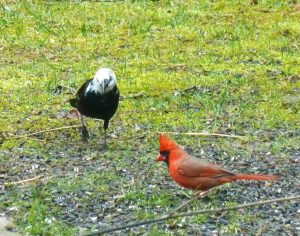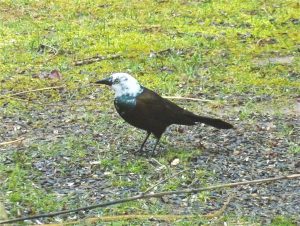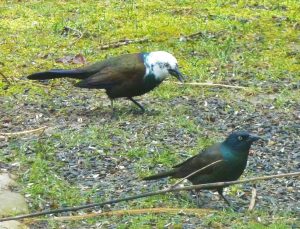The Bald Eagle at the Bird Feeder

If you’re stuck at home like most of us, you might find yourself absentmindedly staring out the window and gazing at the birds. And if you’re like me, you might make an amazing discovery: with its stunning white head, is that a bald eagle at the bird feeder?
Nope, just the genetic oddball that is a leucistic grackle. Which, in a way, is even cooler, if not rarer! But what exactly is a “leucistic” animal? The genes for leucism cause some or all of the pigment cells in an animal to be defective. A leucistic animal might be all white, or it might just have unusual white patches, as our grackle does across its head. These leucistic genes cause the piebald (white-patchy) effect in horses, cows, and even dogs and cats. Interestingly, the genes for leucism don’t affect an animal’s eyes. This leucistic grackle has its normal yellowish eye color. If you’re wondering how to tell a leucistic animal from an albino animal, look to the eyes; unlike our bird, an albino grackle would be whitish across its entire body, but with pink eyes.
So if you find yourself, like I do, staring at screens a lot during this stay-at-home order — your smartphone, the computer, your TV — I’m officially challenging you to rock it old-school and spend some time just staring out the window. Maybe at the birds. Maybe at the trees. Maybe at nothing in particular at all, just looking outside. It takes plenty of luck to have a white-headed leucistic grackle visit you, but with spring migrants passing through and our resident summer birds returning, this is the perfect time to spot something you just might have never seen before, right in your own backyard.


Written by Justin Smith, Community Outreach Interpreter (Southern District)
